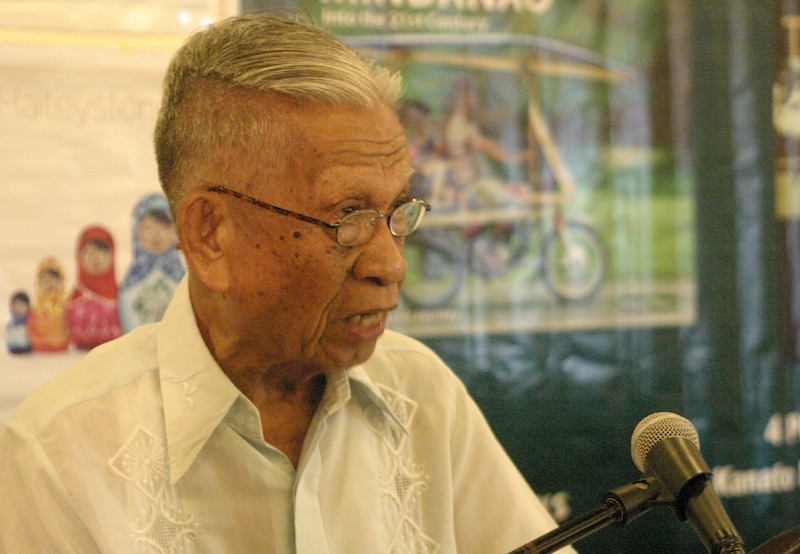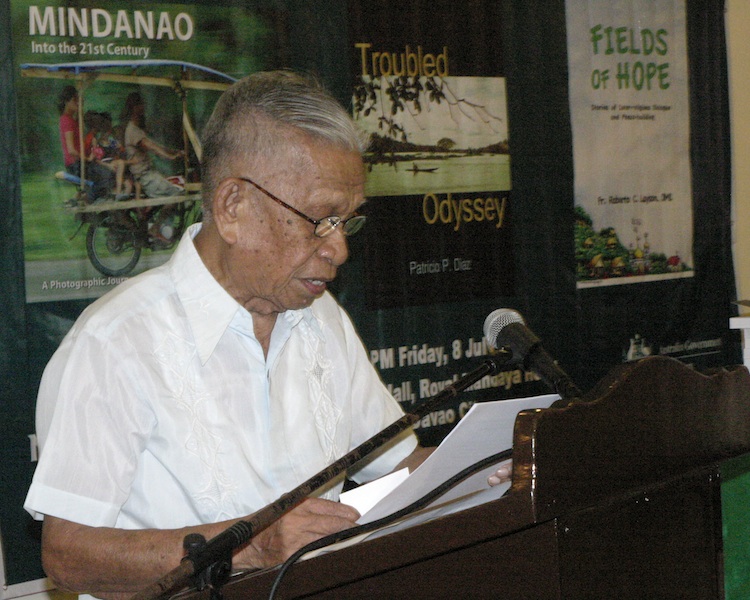DAVAO CITY (MindaNews / 29 August) — Patricio “Pat” Diaz, a former community newspaper editor, MindaNews columnist, author of several books on the Bangsamoro peace process, and chronicler of Mindanao history since 1952, passed away Thursday night in a hospital in General Santos City. He was 93.
Diaz was preparing to leave his residence in General Santos City for his 10 a.m. birthday mass last Sunday, August 25, when he suffered cardiac arrest and was rushed to the St. Elizabeth’s Hospital where he stayed in the intensive care unit until he breathed his last at 6:20 p.m. on Thursday.
 Journalist Patricio P. Diaz, chronicler of Mindanao history for nearly seven decades, passed away on August 29, 2019 at the age of 93. MindanNews file photo by GREGORIO BUENO
Journalist Patricio P. Diaz, chronicler of Mindanao history for nearly seven decades, passed away on August 29, 2019 at the age of 93. MindanNews file photo by GREGORIO BUENO
The birthday mass was supposed to have been officiated by Diaz’ friend, Mindanao’s first Cardinal, Orlando Quevedo, OMI, the Archbishop Emeritus of Cotabato, who also officiated at the mass for the golden wedding anniversary in 2012 of Diaz and his wife Lucy.
Ma. Teresa, his nun-daughter, said her father was “a journalist to the core,” because just before he breathed his last, when his doctor asked how he was feeling, he declared: “I am dying.”
“A declaration of a fact as he is used to realistic journalistic facts, the first public announcement from himself, no other, of his passing to the next life,” she wrote on her FB page.
Her father’s last words, spoken to Maria Lourdes, the eldest of nine children, was “I feel better now.”
“What beautiful words a father would leave his family, friends, colleagues and all those he touched. He truly is one who doesn’t want to bother anybody,” the nun said.
Diaz was honored in 2002 with a “Lifetime Achievement Award” by the Titus Brandsma Awards “for his commitment to education and public information to Mindanawons as Journalist, Educator and Peace Advocate.”
In 2010, the Mindanao Media Forum gave its 1st Agong Award to Diaz for his “well-researched and incisive commentaries on events affecting Mindanao and sharing the fundamental rights and problems of the indigenous peoples and the Bangsamoro; how the settlers transformed the landscape of Mindanao; and how to balance the interests of these peoples who are living in Mindanao.”
Migrant at 13
Diaz was 13 years old when his family migrated to General Santos City from Cabatuan in Iloilo in 1940, as part of the third batch of settlers under the National Land Settlement Authority.
He lived in Cotabato City from 1952 to 1996 as a student, teacher, and journalist.
While teaching English at the Notre Dame University, Diaz wrote for The Mindanao Cross as columnist and reporter, editorial writer-on-call from 1952 to 1967 and was its editor in chief for 21 years — from 1968 to 1989. He also edited and published Mindanao Kris from 1989 to 1996, wrote columns for Mindanao Trend in Cotabato City from 1996 to 2000 and SunStar General Santos from 2000 to 2001, and wrote “Comment” for MindaNews, since its birth in 2001. He wrote short pieces under ‘Mind Da News.”
Diaz returned to General Santos City on May 28, 1996, with his wife Lucila Sabuero Caayaman of Talisayan, Misamis Oriental, and their nine children.
Diaz’s first book, “To Tripoli and Back,” was published in Cotabato City in 1995 and “What Ails Muslim Autonomy?” published in General Santos City in 1998.
MindaNews published three of his books: Understanding Mindanao Conflict in 2003; “The 2010 GRP-MILF Peace Drafts: With Comments and Analysis in 2010” with Mindanao historian Rudy Buhay Rodil; and “Troubled Odyssey: The GRP-MILF Peace Process” in 2011.
In his acceptance speech for the Agong Award in November 2010, Diaz challenged the media to enlighten readers about the situation in Mindanao, citing as example the Bangsamoro peace process and how the “real issues are either ignored or if ever discussed only half-truthfully, laced with historical bias.”
He said contentious issues are “not reconciled but wedged wider and wider apart by fanning the fears of the Christians and the anger of the Moros,” and this was manifested, he said, in the controversy on the Memorandum of Agreement on Ancestral Domain, which the government and Moro Islamic Liberation Front (MILF) peace panels initialed but were not able to sign after the Supreme Court issued a temporary restraining order in August 2008.
He urged reporters to be “straight, upright, clean.”
“The men and women of media must keep Media — as a pillar of democracy in the Philippines — straight, upright, clean. The task is easier said than done but it must be done or democracy will collapse,” he said.
Tribute
In the 2010 awarding, several Mindanawons paid tribute to Diaz through written messages read for the audience by journalists under 30 years old.
 Patricio P. Diaz talks about his book, “Troubled Odyssey: The GRP-MILF Peace Process” during the launching on July 8, 2011 in Davao City. MindaNews file photo by GREGORIO BUENO
Patricio P. Diaz talks about his book, “Troubled Odyssey: The GRP-MILF Peace Process” during the launching on July 8, 2011 in Davao City. MindaNews file photo by GREGORIO BUENO
Historian Rudy Buhay Rodil said Diaz’ thoughts on the peace process were “excellent historical records of a crucial period in Mindanao history.”
“I am what I am now, an expert on Mindanao history and current events because he was my Guro” (teacher), said Rodil, a retired professor who taught history at the Mindanao State University-Iligan Institute of Technology.
Datu Michael Mastura, asked: “How can anyone in the Philippines match Patricio P. Diaz’s pioneering independent reporting and coverage of events in Mindanao? Passing on to his many students the gift of objective analytical insights is itself a great tribute to him.” Mastura said.
Redemptorist brother Karl Gaspar described Diaz as a “mighty prophet” on behalf of Mindanawons who “need to raise their voices for peace, justice, equality, harmony and solidarity among all the peoples of Mindanao!”
Dr. Steven Rood, then country director of The Asia Foundation said Diaz “uses his many years of experience to enlighten the rest of us, who makes sure that we do not forget what has gone before, but who insists on looking forward to a better tomorrow for Mindanao.”
Diaz is survived by wife Lucy, his children — Ma. Lourdes D. Johanson, Patricio Alfonso Jr., Sister Maria Teresa, OND; Tirso Eduardo, Maria Margarita, Ana Margarita, Maria Dolores D. Lo, Ma. Carmela D. Arellano, and Frances Elizabeth – four grandchildren and a great granddaughter. (Carolyn O. Arguillas / MindaNews)
